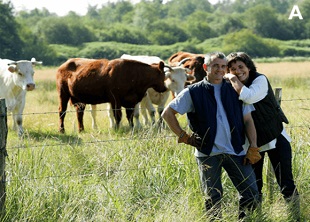Learn the management and repair of pastures
Why study this pasture management course?
Do you want to learn how to establish a successful pasture? Or do you already have one, but you still want to deepen your understanding of how to manage it? Then this course is exactly what you’re looking for!
For farms involved in livestock production, good pasture is the cornerstone of success. Poorly managed pastures are vulnerable to too little or too much rain, temperature increases, overstocking and may only provide poor nutrition leading to increased costs in animal welfare. If you want to improve your pasture and your profitability if running a commercial venture the pasture management course can really help you.
In this online pasture management course you will learn the biology of pasture plants, the different varieties available, how to establish new pastures and how to manage existing pasture, stocking on pasture and more.
Who is this pasture management course for?
This course is designed for anyone running livestock on pasture including cattle, horses, goats etc. The course is suitable for both students working in or running their own commercial property as well as for those seeking to improve their own pasture for private use. At CourseStream we aim to make studying from home easy by providing flexible options.
How does it work?
The course is offered as online and we also send out printed notes (so you don’t have to rely on your internet connection all the time). Our tutors are experienced and friendly and are there to offer guidance as you progress through the course. This course is offered with a 7-day free trial and payment plans from $25.00/week.
- self-paced home study
- 100 hours
- tutor support
- payment plans.
What you will do:
- Determine criteria for selecting appropriate varieties of plants for a pasture.
- Identify characteristics of a pasture plant which are relevant to both making an identification, and to considering its value as a pasture species.
- Evaluate the potential of given sites for pasture development programs.
- Explain the procedures used in managing the establishment of pasture.
- Explain the techniques used in managing pasture which is already been established
- Assess the commercial and nutritional value of pasture species in the context of farm.
- animal feed, and determine appropriate ways of managing stock.
- Develop an appropriate work program for the management of a pasture by a farmer.
Course Outline
There are 8 lessons in this course:
- Introduction to Pastures
- Pasture Improvement
- Choosing a Pasture Mix
- Seed Coating
- Variety Selection
- Sustainability
- Definitions
- The Pasture Plant
- Grasses
- The grass plant
- Growth and development
- Phases of development
- Annual and perennial grasses
- Carbohydrate sinks
- The physiology of grasses
- The structure of grasses
- Growth habits
- Legumes
- Pasture Varieties
- Introduction to common pasture grasses
- Identifying grasses
- Legumes
- The Importance of Legumes in Pasture
- Nitrogen Fixation in Legumes
- The Rhizobium bacteria
- Common legumes
- Grasses to Grow With Clovers
- Site Considerations
- Managing pastures
- Choosing the Correct Site for a Pasture
- Choosing the correct seed mix
- Seed quality
- Establishing New Pastures
- Preparation of the land for pasture
- Prepared seedbed
- Sowing
- Germination
- Direct drilling
- Weed control
- Seeders
- Grazing new pastures
- Managing Existing Pastures
- Native Grasses versus Pasture
- Carrying Capacity of Native Grasses
- Stocking Rate of Native Grass Areas
- The Establishment of the Native Grasslands
- The developing grasslands
- How grasslands deteriorate
- Factors promoting succession or retrogression
- Limiting factors and terminal plant communities
- Allogenic Factors
- Autogenic Factors
- Rests To Promote Rapid Growth
- Rests to change the composition of the community
- Rests designed to eliminate or control bush encroachment
- Rests to accumulate grazing material
- Rests to provide out of season fodder
- Physiological aspects
- Managing Stock on Pasture
- Factors affecting food intake by animals
- Animal factors
- Feed factors
- Grazing factors
- Grazing behaviour
- Complementary Grazing
- Rank Order of Dominance
- Selective Grazing
- Ruminant Time
- Herd group behaviour
- Grazing Time
- Pasture management principles – rest, grazing period, stocking, carrying capacity
- Equal Utilisation or the Removal of the Top Hamper, paddock size, number in herd etc
- Grassland management principles – Split – season Systems, Continuous Light Stocking, One Herd, Four Paddock System, Intensive systems etc
- Horse pastures
- Food trees and shrubs
- Pasture Management Work Tasks
- Fertilizer
- Pest and weed control
- Biological control
- Advantages of Biological Methods
- Disadvantages of Biological Methods
- Irrigation
- Fallowing
- Cultivation
- Pasture renovation
- Managing pasture after drought
- Managing pasture after fire
Enrol Now
- Experienced Tutor support
- Certificate sent to you
- Online study (Printed notes available)
- Self paced - no set timetable
- 12 months to complete course
From: $25.00 / week for 26 weeks
Get a Free Info Pack!











